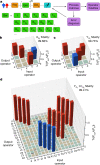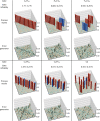Quantum logic with spin qubits crossing the surface code threshold
- PMID: 35046604
- PMCID: PMC8770146
- DOI: 10.1038/s41586-021-04273-w
Quantum logic with spin qubits crossing the surface code threshold
Abstract
High-fidelity control of quantum bits is paramount for the reliable execution of quantum algorithms and for achieving fault tolerance-the ability to correct errors faster than they occur1. The central requirement for fault tolerance is expressed in terms of an error threshold. Whereas the actual threshold depends on many details, a common target is the approximately 1% error threshold of the well-known surface code2,3. Reaching two-qubit gate fidelities above 99% has been a long-standing major goal for semiconductor spin qubits. These qubits are promising for scaling, as they can leverage advanced semiconductor technology4. Here we report a spin-based quantum processor in silicon with single-qubit and two-qubit gate fidelities, all of which are above 99.5%, extracted from gate-set tomography. The average single-qubit gate fidelities remain above 99% when including crosstalk and idling errors on the neighbouring qubit. Using this high-fidelity gate set, we execute the demanding task of calculating molecular ground-state energies using a variational quantum eigensolver algorithm5. Having surpassed the 99% barrier for the two-qubit gate fidelity, semiconductor qubits are well positioned on the path to fault tolerance and to possible applications in the era of noisy intermediate-scale quantum devices.
© 2022. The Author(s).
Conflict of interest statement
The authors declare no competing interests.
Figures











Comment in
-
Silicon qubits move a step closer to achieving error correction.Nature. 2022 Jan;601(7893):320-322. doi: 10.1038/d41586-022-00047-0. Nature. 2022. PMID: 35046596 No abstract available.
References
-
- Lidar, D. A. & Brun, T. A. Quantum Error Correction (Cambridge Univ. Press, 2013).
-
- Raussendorf R, Harrington J. Fault-tolerant quantum computation with high threshold in two dimensions. Phys. Rev. Lett. 2007;98:190504. - PubMed
-
- Fowler AG, Mariantoni M, Martinis JM, Cleland AN. Surface codes: towards practical large-scale quantum computation. Phys. Rev. A. 2012;86:032324.
-
- Zwerver, A. M. J. et al. Qubits made by advanced semiconductor manufacturing. Preprint at https://arxiv.org/abs/2101.12650 (2021).
-
- McArdle S, Endo S, Aspuru-Guzik A, Benjamin SC, Yuan X. Quantum computational chemistry. Rev. Mod. Phys. 2020;92:015003.
Publication types
LinkOut - more resources
Full Text Sources
Other Literature Sources

